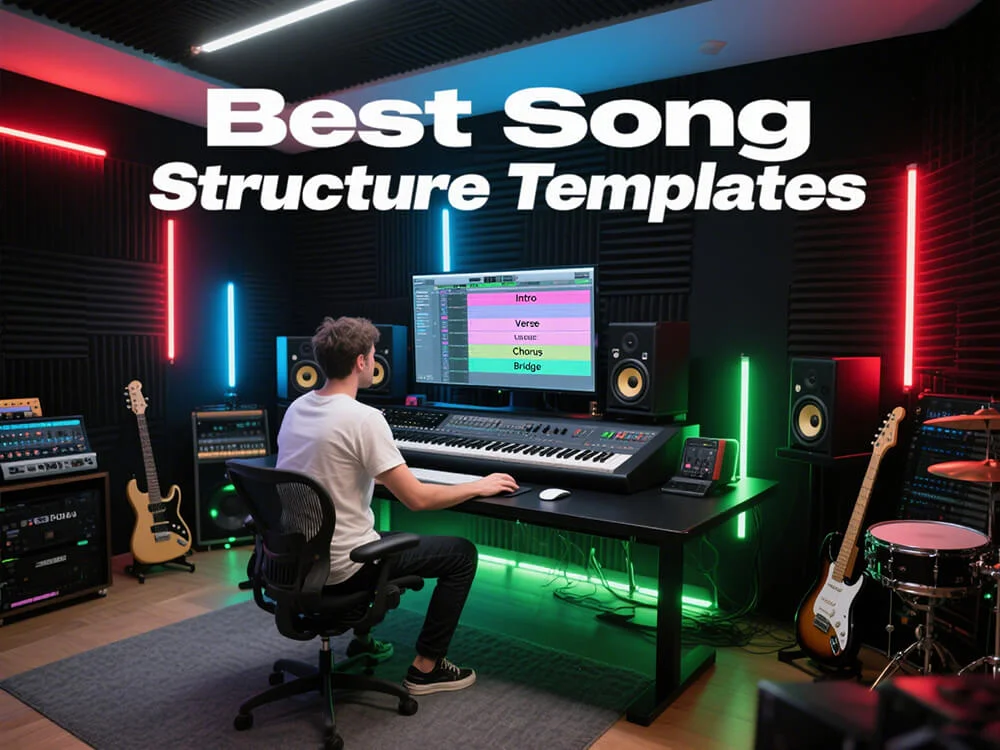
7 Proven Song Structure Templates Every Music Producer Should Know
Updated at: 2025-08-12 09:33:42
Ever opened your DAW only to sit in silence, unsure how to begin your next song? Beginners and seasoned producers alike often hit creative roadblocks. But here's the good news: you don't have to start from scratch. Song structure templates offer a proven starting point that gives your music instant direction and makes the creative process more efficient.
These templates are essentially blueprints for arranging your song's key components—like verses, choruses, and bridges—in a way that keeps listeners engaged. With the right structure, your song flows naturally, matches audience expectations, and is easier to produce. In this guide, we’ll explore some of the most effective song structure templates used across genres by professional and amateur music producers alike.
1.The Classic Pop Song Structure
Template:
Intro → Verse → Chorus → Verse → Chorus → Bridge → Chorus
This structure is the go-to formula for crafting catchy, chart-topping hits. It starts with an attention-grabbing intro, builds momentum through the verses, and delivers a high-energy payoff in the choruses.
Why it works: Familiarity and repetition make it easy for listeners to connect and sing along. The bridge offers contrast before returning to a final, memorable chorus.
Best for: Mainstream pop, dance-pop, vocal EDM, and commercial radio tracks.
2.The Hip-Hop Blueprint
Template:
Intro → Verse → Chorus → Verse → Chorus → Outro
This layout is designed for lyrical storytelling and flow. The verses provide space for complex bars, while the hook ties it all together.
Why it works: It balances repetition with narrative. The clean structure supports strong beat transitions and lyrical development.
Best for: Hip-hop, trap, drill, boom bap, and freestyle-based productions.
3.The EDM Build-and-Drop
Template:
Intro → Build → Drop → Breakdown → Build → Drop → Outro
In electronic music production, energy and timing are everything. This template thrives on rising tension and massive drops.
Why it works: It gives producers room to manipulate dynamics and drive emotional responses on the dancefloor.
Best for: House, techno, dubstep, future bass, trance, and other high-energy electronic genres.
4.The Singer-Songwriter Flow
Template:
Verse → Chorus → Verse → Chorus → Bridge → Chorus
This simple, emotional structure supports intimate vocals and expressive lyrics. It allows stories to unfold organically.
Why it works: Focused on vocal and lyrical content, it’s easy to follow and creates space for emotional development.
Best for: Acoustic, folk, indie pop, ballads, and lo-fi.
5.The Rock Band Formula
Template:
Intro → Verse → Pre-Chorus → Chorus → Verse → Pre-Chorus → Chorus → Solo/Bridge → Chorus
This arrangement allows bands to highlight instrumentation, build momentum, and deliver high-impact choruses.
Why it works: The pre-chorus acts as a springboard into the chorus, while the bridge or solo showcases musical prowess.
Best for: Pop-punk, hard rock, indie rock, metal, and alternative genres.
6.The Experimental Template
Template:
Freeform or custom arrangement (e.g., A → B → C → A2 → D)
Sometimes rules are meant to be broken. This structure is intentionally flexible and often avoids traditional repetition.
Why it works: It promotes creativity, genre-blending, and abstract sonic storytelling.
Best for: Ambient, progressive, cinematic scoring, avant-garde, and art pop.
7.The Short-Form TikTok Hook
Template:
Hook → Verse → Hook → Outro
This ultra-condensed structure is optimized for short-form content platforms like TikTok or Instagram Reels.
Why it works: Front-loading the hook ensures maximum engagement within the first few seconds, boosting your chances of going viral.
Best for: Viral music, content loops, social media snippets, and meme-friendly tracks.
Conclusion
The structure of your song isn't just about arrangement—it sets the tone for your listener's entire experience. When producing for streaming platforms, social media, or live shows, choosing the right song structure template helps your track land with more impact.
Try experimenting with a few of these templates to discover what complements your style. Mix and match sections to build a hybrid format that feels authentic to your sound.
Looking to speed up your workflow? Choose a song structure template that fits your genre and let it serve as the creative foundation for your next release. Structure isn't a limitation—it’s a launchpad for your music production.
FAQs
What is a song structure template?
A song structure template is a predefined arrangement of musical sections—like verses, choruses, and bridges—that guides the composition of a song. It helps producers and songwriters organize their ideas effectively.
Are song structure templates only for beginners?
Not at all. Even professional producers and artists use templates to streamline their workflow, maintain consistency, and experiment within a framework.
Can I modify a template to fit my song?
Absolutely. Song structure templates are starting points, not rigid rules. You’re encouraged to tweak, expand, or combine them to match your creative vision.
Which song structure is best for social media platforms?
Short-form structures like "Hook → Verse → Hook" are ideal for platforms like TikTok and Instagram Reels, where immediate engagement is key.
Do different genres have different standard structures?
Yes. Pop, hip-hop, rock, and EDM each tend to follow distinct structural conventions that align with audience expectations.
How do I know which structure fits my music?
Consider your genre, audience, and song’s purpose. Experiment with different templates and listen to reference tracks to find a format that supports your ideas.
